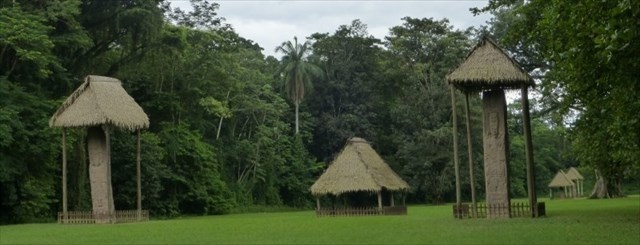Quiriguá Arenisca

España:
Quiriguá
Este Earthcache se encuentra en el sitio arqueológico de Quiriguá. El sitio maya precolombino es Patrimonio de la Humanidad de la UNESCO desde 1981. Es famoso por sus estelas de arenisca talladas profundas bien preparadas.
Arenisca
La piedra arenisca es una roca sedimentaria (a veces conocida como anonita) compuesta principalmente por minerales del tamaño de la arena o granos de roca. Es de origen clástico, lo que significa que está compuesto de fragmentos o clastos de rocas preexistentes. El tamaño de grano está entre 0,063 y 2 mm.
La piedra arenisca se puede desarrollar en (antiguos) mares. El material necesario, la arena, vino del continente y fue transportado por ríos y corrientes marinas. Pero también en el continente, se puede desarrollar arenisca. Aquí el transporte es hecho por el viento y el agua, pero la mayoría de la piedra arenisca depositada fue hecha por los ríos.
La solidificación de la arena depositada ocurre por la presión de capas superpuestas, productos químicos naturales del agua de mar o subterránea y mucho tiempo, naturalmente. El proceso puede persistir desde solo algunas décadas hasta varios millones de años.
La arenisca en Quiriguá es una arenisca roja dura, utilizada por los habitantes para la construcción de monumentos y arquitectura. Debido a que la piedra arenisca local es muy fuerte y no propensa a cortarse o fracturarse, los escultores de Quiriguá pudieron erigir los monumentos de piedra independientes más altos de las Américas.
Tenga en cuenta que el área es un monumento cultural y subyace a las restricciones correspondientes.
Para el permiso de registro, resuelva las siguientes tareas y envíenos el resultado a través de la función de correo. Después de enviar sus respuestas, siéntase libre de registrarlo como encontrado inmediatamente, contestaremos su correo en cualquier caso ;-)
1. Describa con sus propias palabras las estelas de arenisca in situ en relación con la superficie, el color y el tamaño del grano (¿hay elementos más grandes de lo normal?).
2. Estime el peso de Stele J (listado de coords), usando un peso específico medio para arenisca de 2500 kg / m³.
3. Agregue una foto de su estadía en Quiriguá a su registro. (Esto no es una obligación, pero nos daría un placer. Sé creativo ;-)
English:
Quiriguá
This Earthcache is located at the archeological site of Quiriguá. The pre-colombian maya site is an UNESCO World Heritage since 1981. It is famous for its well prepared, deep carved sandstone steles.
Sandstone
Sandstone is a sedimentary rock (sometimes known as anonite) composed mainly of sand-size minerals or rock grains. It's clastic in origin, meaning it's composed of fragments or clasts of pre-existing rocks. The grain size is between 0,063 and 2 mm.
Sandstone can be developed in (former) seas. The necessary material, the sand, came from the mainland and was transported by rivers and sea current. But also on the mainland, sandstone can be developed. Here transportation is done by wind and water, but most deposited sandstone was done by rivers.
The solidification of deposited sand happens by pressure of overlaying layers, natural chemicals of sea- or groundwater and a lot of time, naturally. The process can persist from only few decades up to several million years.
The sandstone in Quiriguá is a hard red sandstone, used by the inhabitants for the construction of monuments and architecture. Because the local sandstone is very strong and not prone to shearing or fracturing, the sculptors at Quiriguá were able to erect the tallest freestanding stone monuments in the Americas.
Please keep in mind, that the area is a cultural monument and underlies accordingly restrictions.
For log permission please solve the following tasks and sent us the result via the mail function. After sending your answers, feel free to log immediately, we will answer your mail in any case ;-)
1. Describe in your own words the sandstone steles onsite in relation of surface, color and grain size (are there larger elements than usual?).
2. Estimate the weight of Stele J (Listing coords), using a medium specific weight for sandstone of 2500 kg/m³.
3. Please add a photo of your stay at Quiriguá to your log. (this is no obligation, but it would give us a pleasure. Be creativ ;-)
Copyright note:
The german, english and spanish version of Wikipedia was used as source for the earthcache lesson.
Viel Spaß! Have fun! ¡Que te diviertas!
Die Pädeldreter